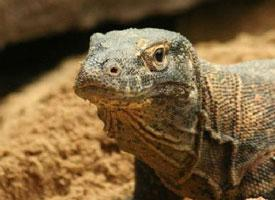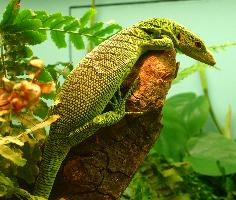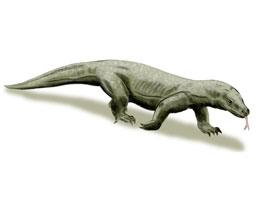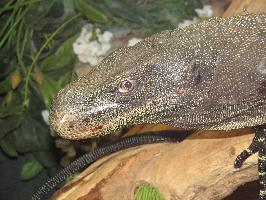
Váhy a míry
| Délka | 3,5 m |
|---|
Stav ohrožení
| Ohrožen |
Popis zvířete
The Komodo dragon (Varanus komodoensis), often referred to as the Komodo monitor, is a remarkable species of large lizard found in the Indonesian islands of Komodo, Rinca, Flores, and Gili Motang. This fascinating creature is renowned for being the largest living species of lizard, with adult males averaging around 2.6 meters (8.5 feet) in length and weighing around 70 to 90 kilograms (154 to 198 pounds), though exceptional specimens have been recorded at lengths of over 3 meters (10 feet) and weights of approximately 135 kilograms (298 pounds). Females are generally smaller than males.Komodo dragons are apex predators in their ecosystem, a status underscored by their formidable size, powerful physique, and an array of adaptations that make them highly effective hunters. Their diet is carnivorous, feeding on a variety of prey including invertebrates, birds, and mammals. Notably, they are capable of taking down large prey such as deer, pigs, and even water buffalos, employing a wait-and-ambush strategy. They have also been known to consume smaller members of their own species and occasionally engage in cannibalistic behavior.
One of the most intriguing aspects of the Komodo dragon's biology is its venomous bite, a characteristic that has been the subject of much scientific interest and debate. Initially, it was believed that bacteria in the dragon's saliva were responsible for the rapid decline of prey post-bite, but more recent research has demonstrated the presence of venom glands in the jaws of Komodo dragons. This venom contains a mix of toxins that induce shock through anticoagulation and hypotension, weakening the prey and leading to a fatal outcome.
Physically, Komodo dragons possess robust bodies, supported by strong, bowed legs and equipped with sharp claws that are useful both in capturing prey and climbing. Their skin is thick and armored with osteoderms, providing a layer of protection. The dragon's head is long and flat, with a rounded snout and about 60 serrated teeth that are frequently replaced throughout its life. Their forked tongues, which flick in and out, serve as a sensory tool, capturing chemical signals from the air and delivering them to the Jacobson's organ in the mouth for analysis, a process similar to that observed in snakes.
Komodo dragons are solitary animals, coming together only to breed. Mating occurs between May and August, with females laying their eggs in September. A clutch can contain up to 30 eggs, which are deposited in abandoned megapode nests or in self-dug nesting holes. The eggs incubate for approximately eight months before hatching. Young dragons spend the early years of their lives in trees, where they are relatively safe from predators, including cannibalistic adults.
The conservation status of the Komodo dragon is currently listed as Vulnerable by the International Union for Conservation of Nature (IUCN), primarily due to habitat loss, human encroachment, and natural disasters. Conservation efforts are in place to protect these magnificent creatures and their habitat, including the establishment of the Komodo National Park.
In summary, the Komodo dragon is a fascinating and formidable creature, representing a prehistoric era with its size, appearance, and hunting prowess. It is a symbol of the rich biodiversity found in Indonesia and a subject of great interest and study in the fields of zoology, herpetology, and conservation science.
Podobná zvířata
Nové fotografie zvířat
Top 10 zvířat
- Chinese water dragon (Physignathus cocincinus)
- Galápagos tortoise (Geochelone nigra complex)
- Dolphin gull (Leucophaeus scoresbii)
- Japanese macaque (Macaca fuscata)
- Colombian red howler (Alouatta seniculus)
- Sea urchins (Echinoidea)
- Moustached guenon (Cercopithecus cephus)
- Diana monkey (Cercopithecus diana)
- Common reed warbler (Acrocephalus scirpaceus)
- Common house mosquito (Culex pipiens)


